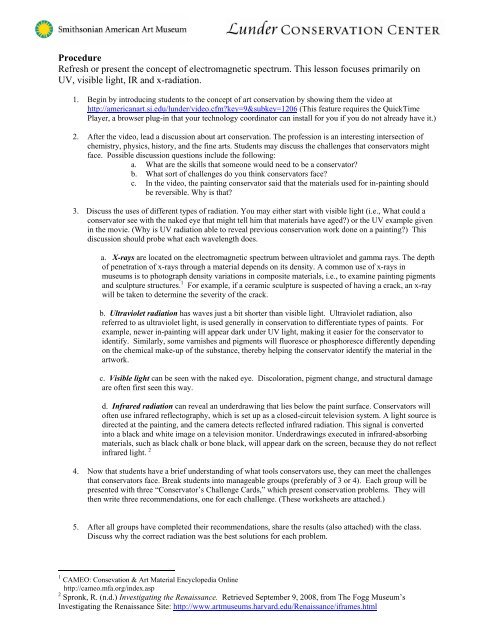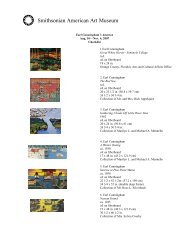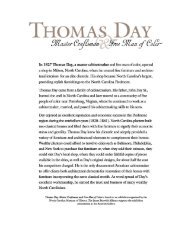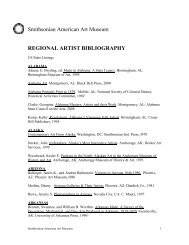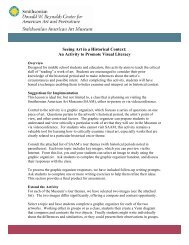Art and the Electromagnetic Spectrum: A Classroom Lesson
Art and the Electromagnetic Spectrum: A Classroom Lesson
Art and the Electromagnetic Spectrum: A Classroom Lesson
You also want an ePaper? Increase the reach of your titles
YUMPU automatically turns print PDFs into web optimized ePapers that Google loves.
Procedure<br />
Refresh or present <strong>the</strong> concept of electromagnetic spectrum. This lesson focuses primarily on<br />
UV, visible light, IR <strong>and</strong> x-radiation.<br />
1. Begin by introducing students to <strong>the</strong> concept of art conservation by showing <strong>the</strong>m <strong>the</strong> video at<br />
http://americanart.si.edu/lunder/video.cfm?key=9&subkey=1206 (This feature requires <strong>the</strong> QuickTime<br />
Player, a browser plug-in that your technology coordinator can install for you if you do not already have it.)<br />
2. After <strong>the</strong> video, lead a discussion about art conservation. The profession is an interesting intersection of<br />
chemistry, physics, history, <strong>and</strong> <strong>the</strong> fine arts. Students may discuss <strong>the</strong> challenges that conservators might<br />
face. Possible discussion questions include <strong>the</strong> following:<br />
a. What are <strong>the</strong> skills that someone would need to be a conservator?<br />
b. What sort of challenges do you think conservators face?<br />
c. In <strong>the</strong> video, <strong>the</strong> painting conservator said that <strong>the</strong> materials used for in-painting should<br />
be reversible. Why is that?<br />
3. Discuss <strong>the</strong> uses of different types of radiation. You may ei<strong>the</strong>r start with visible light (i.e., What could a<br />
conservator see with <strong>the</strong> naked eye that might tell him that materials have aged?) or <strong>the</strong> UV example given<br />
in <strong>the</strong> movie. (Why is UV radiation able to reveal previous conservation work done on a painting?) This<br />
discussion should probe what each wavelength does.<br />
a. X-rays are located on <strong>the</strong> electromagnetic spectrum between ultraviolet <strong>and</strong> gamma rays. The depth<br />
of penetration of x-rays through a material depends on its density. A common use of x-rays in<br />
museums is to photograph density variations in composite materials, i.e., to examine painting pigments<br />
<strong>and</strong> sculpture structures. 1 For example, if a ceramic sculpture is suspected of having a crack, an x-ray<br />
will be taken to determine <strong>the</strong> severity of <strong>the</strong> crack.<br />
b. Ultraviolet radiation has waves just a bit shorter than visible light. Ultraviolet radiation, also<br />
referred to as ultraviolet light, is used generally in conservation to differentiate types of paints. For<br />
example, newer in-painting will appear dark under UV light, making it easier for <strong>the</strong> conservator to<br />
identify. Similarly, some varnishes <strong>and</strong> pigments will fluoresce or phosphoresce differently depending<br />
on <strong>the</strong> chemical make-up of <strong>the</strong> substance, <strong>the</strong>reby helping <strong>the</strong> conservator identify <strong>the</strong> material in <strong>the</strong><br />
artwork.<br />
c. Visible light can be seen with <strong>the</strong> naked eye. Discoloration, pigment change, <strong>and</strong> structural damage<br />
are often first seen this way.<br />
d. Infrared radiation can reveal an underdrawing that lies below <strong>the</strong> paint surface. Conservators will<br />
often use infrared reflectography, which is set up as a closed-circuit television system. A light source is<br />
directed at <strong>the</strong> painting, <strong>and</strong> <strong>the</strong> camera detects reflected infrared radiation. This signal is converted<br />
into a black <strong>and</strong> white image on a television monitor. Underdrawings executed in infrared-absorbing<br />
materials, such as black chalk or bone black, will appear dark on <strong>the</strong> screen, because <strong>the</strong>y do not reflect<br />
infrared light. 2<br />
4. Now that students have a brief underst<strong>and</strong>ing of what tools conservators use, <strong>the</strong>y can meet <strong>the</strong> challenges<br />
that conservators face. Break students into manageable groups (preferably of 3 or 4). Each group will be<br />
presented with three “Conservator’s Challenge Cards,” which present conservation problems. They will<br />
<strong>the</strong>n write three recommendations, one for each challenge. (These worksheets are attached.)<br />
5. After all groups have completed <strong>the</strong>ir recommendations, share <strong>the</strong> results (also attached) with <strong>the</strong> class.<br />
Discuss why <strong>the</strong> correct radiation was <strong>the</strong> best solutions for each problem.<br />
1 CAMEO: Consevation & <strong>Art</strong> Material Encyclopedia Online<br />
http://cameo.mfa.org/index.asp<br />
2 Spronk, R. (n.d.) Investigating <strong>the</strong> Renaissance. Retrieved September 9, 2008, from The Fogg Museum’s<br />
Investigating <strong>the</strong> Renaissance Site: http://www.artmuseums.harvard.edu/Renaissance/iframes.html


